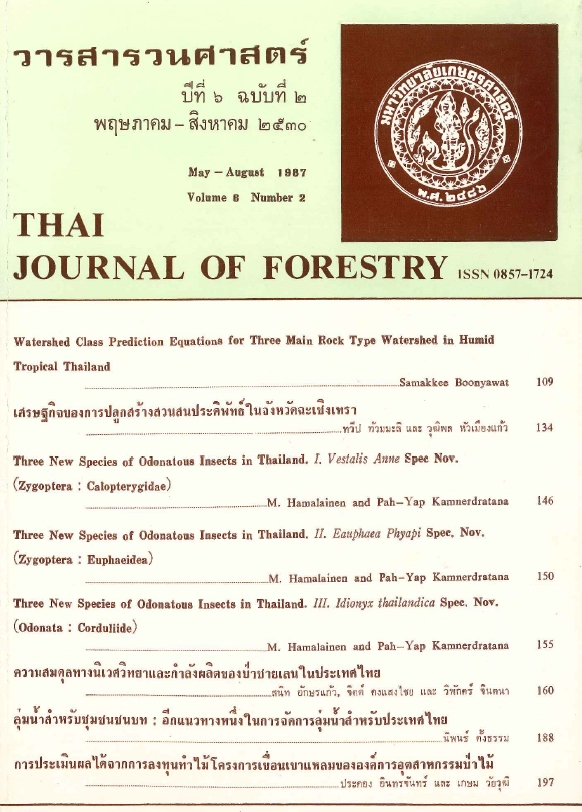ความสมดุลทางนิเวศวิทยาและกำลังผลิตของป่าชายเลนในประเทศไทย
Main Article Content
บทคัดย่อ
การศึกษาความสมดุลทางนิเวศวิทยาและกำลังผลิตของป่าชายเลนในประเทศไทย ได้ดำเนินการเก็บข้อมูลในบริเวณป่าชายเลน ตำบลหาดทรายขาว จังหวัดระนอง โดยทำเป็นแปลงตัวอย่างถาวร และเก็บข้อมูลหลายด้านรวมถึงลักษณะโครงสร้างของป่า อัตราการเจริญเติบโตของไม้ขนาดใหญ่ และการเจริญเติบโตของลูกไม้ชีวภาพของป่าทั้งเหนือดินและใต้ดิน ปริมาณการร่วงหล่นและการสลายตัวของเศษไม้ใบไม้ ตลอดจนปริมาณธาตุอาหารที่ผลิตได้จากป่าชายเลนโดยเฉพาะจากปริมาณเศษไม้ใบไม้ ผลของการศึกษาวิจัยพอสรุปได้ว่า ลักษณะโครงสร้างของป่าชายเลนประกอบด้วยพันธุ์ไม้หลายชนิด และที่สำคัญคือ ลำแพน โกงกางใบเล็ก โกงกางใบใหญ่ ถั่วขาว ถั่วดำ โปรง และตะบูนขาว ซึ่งมีการขึ้นอยู่เป็นกลุ่มหรือเขต กล่าวคือเขตป่าด้านนอกติดริมน้ำจะเป็นพวกลำแพน ถัดเข้าไปเป็นพวกโกงกาง พวกถั่ว-โปรง และตะบูน เป็นกลุ่มไม้ขึ้นอยู่ด้านในสุดของป่า ความหนาแน่นของไม้ในป่าจะแตกต่างไปตามกลุ่มของไม้มีประมาณ ๕๐๐-๘,๙๐๐ ต้นต่อไร่ และมีพื้นที่หน้าตัดประมาณ ๑๙-๒๐๐ ตารางเมตรต่อไร่ อัตราการเจริญเติบโตหรือความเพิ่มพูนทางด้านเส้นผ่าศูนย์กลางเพียงอกของไม้ขนาดใหญ่เหล่านี้จะแตกต่างไปตามชนิดของพันธุ์ไม้ มีค่าระหว่าง ๐.๑-๐.๗ เซนติเมตรต่อปี การสืบพันธุ์ตามธรรมชาติของลูกไม้ค่อนข้างสมบูรณ์ มีความหนาแน่นประมาณ ๓๒,๐๐๐ ตันต่อไร่ ซึ่งส่วนใหญ่ประมาณ ๔๑ เปอร์เซนต์ เป็นลูกไม้โกงกางใบเล็ก อัตราการเจริญเติบโตของลูกไม้แตกต่างไปตามชนิดของพันธุ์ไม้ คืออัตราการเจริญเติบโตทางความสูงระหว่าง ๓๐-๕๔ เซ็นติเมตรต่อปี และอัตราการเจริญเติบโตทางด้านเส้นผ่าศูนย์กลางเหนือคอรากประมาณ ๐.๖-๑.๘ เซนติเมตรต่อปี และอัตราการรอดตายของลูกไม้ทุกชนิดประมาณ ๗๕-๑๐๐ เปอร์เซนต์ สำหรับมวลชีวภาพของป่าชายเลนในเขตต่าง ๆ ของพรรณไม้ ซึ่งรวมถึงน้ำหนักลำต้น ใบ ถึงและรากไม้ในส่วนเหนืเหนือพื้นดินในดินมีทั้งหมดประมาณ ๓-๒๑ ตันน้ำหนักแห้งต่อไร่ แต่จากการศึกษาน้ำหนักรากใต้ผิวดินอย่างเดียวกันอย่างเดียวมีน้ำหนักถึง ๗๐ ตันน้ำหนักแห้งต่อไร่ สำหรับปริมาณการร่วงหล่นของเศษไม้ใบไม้ มีประมาณ ๑.๔ ตันต่อไร่ต่อปี และมีการสลายตัวประมาณ ๑.๕๙ ตันต่อไร่ต่อปี หรือ ๔๑ เปอร์เซนต์ของประมาณเศษใบไม้ที่ร่วงหล่นทั้งหมด ปริมาณธาตุอาหารโดยเฉพาะไนโตรเจน ฟอสฟอรัส โปแตสเซียม แคลเซียม แมกเนเซียมและโซเดียม ที่ผลิตได้ในป่าชายเลนจากการร่วงหล่นของเศษไม้ใบไม้ทั้งหมดประมาณ ๔๙.๐ กิโลกรัมต่อไร่ต่อปี
Downloads
Article Details

อนุญาตภายใต้เงื่อนไข Creative Commons Attribution-NonCommercial-NoDerivatives 4.0 International License.
ข้าพเจ้าและผู้เขียนร่วม (ถ้ามี) ขอรับรองว่า ต้นฉบับที่เสนอมานี้ยังไม่เคยได้รับการตีพิมพ์และไม่ได้อยู่ในระหว่างกระบวนการพิจารณาตีพิมพ์ลงในวารสารหรือสิ่งตีพิมพ์อื่นใด ข้าพเจ้าและผู้เขียนร่วม (ถ้ามี) ยอมรับหลักเกณฑ์และเงื่อนไขการพิจารณาต้นฉบับ ทั้งยินยอมให้กองบรรณาธิการมีสิทธิ์พิจารณาและตรวจแก้ต้นฉบับได้ตามที่เห็นสมควร พร้อมนี้ขอมอบลิขสิทธิ์ผลงานที่ได้รับการตีพิมพ์ให้แก่วารสารวนศาสตร์ คณะวนศาสตร์ มหาวิทยาลัยเกษตรศาสตร์ กรณีมีการฟ้องร้องเรื่องการละเมิดลิขสิทธิ์เกี่ยวกับภาพ กราฟ ข้อความส่วนใดส่วนหนึ่ง หรือ ข้อคิดเห็นที่ปรากฏในผลงาน ให้เป็นความรับผิดชอบของข้าพเจ้าและผู้เขียนร่วม (ถ้ามี) แต่เพียงฝ่ายเดียว และหากข้าพเจ้าและผู้เขียนร่วม (ถ้ามี) ประสงค์ถอนบทความในระหว่างกระบวนการพิจารณาของทางวารสาร ข้าพเจ้าและผู้เขียนร่วม (ถ้ามี) ยินดีรับผิดชอบค่าใช้จ่ายทั้งหมดที่เกิดขึ้นในกระบวนการพิจารณาบทความนั้น”


